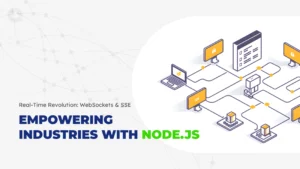
The stock market is a complex and dynamic industry that is constantly evolving. It is a place where individuals and companies buy and sell stocks, bonds, and other securities to raise capital and invest in the future. The stock market plays an important role in the economy and is an important indicator of the health of a country’s financial sector.
In recent years, technology has revolutionized the stock market and made it easier for individuals to invest. One technology that has had a significant impact on the stock market is Node.js. Node.js is a JavaScript runtime built on Chrome’s V8 JavaScript engine. It is a powerful tool for building fast, scalable, and efficient applications. In this blog, we will explore how Node.js is used in the stock market and why it is becoming increasingly popular in this industry.
What is Node.js?
Node.js is an open-source, cross-platform, back-end JavaScript runtime environment used for developing web applications. It is based on the V8 JavaScript engine and is known for its fast performance, scalability, and ease of use.
Why use Node.js for Stock Market Web Application?
Node.js is a perfect choice for developing stock market web applications due to its fast and efficient handling of real-time data. This makes it ideal for applications that require quick and reliable data updates, such as stock market trading applications.
Node.js and Real-Time Data
One of the main advantages of Node.js in the stock market is its ability to handle real-time data. The stock market is all about timing, and being able to access real-time data is critical to making informed investment decisions. Node.js makes it possible to handle real-time data by using its non-blocking I/O and event-driven architecture. This allows applications built with Node.js to handle multiple requests and events simultaneously, which is essential for handling real-time data in the stock market.
Node.js and Scalability
Another advantage of Node.js in the stock market is its scalability. The stock market is a fast-paced industry that requires systems to be able to handle large amounts of data and transactions. Node.js is designed to be scalable, making it an ideal choice for applications in the stock market. Node.js uses a single-threaded event loop to handle multiple requests, which means that applications built with Node.js can handle increasing amounts of data and transactions as the needs of the stock market evolve.
Node.js and Flexibility
Flexibility is also an important consideration in the stock market, and Node.js is a highly flexible technology. Node.js applications can be easily adapted to changing requirements and can be modified to support new features and functionality. This makes it ideal for use in the stock market, where requirements can change rapidly and new opportunities can emerge quickly.
Node.js and Cost-Effectiveness
Finally, Node.js is a cost-effective technology for the stock market. The stock market is a complex and dynamic industry, and investing in technology can be expensive. Node.js is an open-source technology, which means that it can be used without incurring licensing fees. This makes it an attractive option for companies in the stock market that are looking to reduce costs and maximize their investment.
Here are the steps to create a basic stock market web application using Node.js:
1). Gather Data: The first step is to gather data on the stocks you wish to track. You can obtain this data from a variety of sources such as APIs, financial news websites, and stock market data providers.
2). Set up the Backend: To get started, you will need to set up the backend of your application. This involves creating a server using Node.js and connecting it to a database where you can store your stock market data.
3). Create RESTful API: You can create RESTful APIs to retrieve and update your stock market data. This allows you to access your data from any platform or device that has access to the internet.
4). Design the Frontend: With the backend set up, you can now focus on designing the front end of your application. You can use a front-end framework such as React or Angular to build a user-friendly interface for your users.
5). Display Data: Once you have your APIs and frontend in place, you can start displaying your stock market data in real time. You can use graphs, charts, and other visual aids to help your users understand the data and make informed decisions.
6). Deploy: Finally, you can deploy your stock market web application to a hosting platform such as Heroku or Amazon Web Services.
Conclusion
In conclusion, Node.js is a powerful technology that is becoming increasingly popular in the stock market. Its ability to handle real-time data, scalability, flexibility and cost-effectiveness make it an ideal choice for applications in this industry. As the stock market continues to evolve, it is likely that we will see even more applications built with Node.js in the future. Whether you are a professional trader or a casual investor, it is worth keeping an eye on this technology and its impact on the stock market.
Frequently asked questions
Scalability: Node.js is highly scalable and can handle large amounts of concurrent requests, making it well suited for stock market applications that need to handle real-time data.
Performance: Node.js is built on the V8 JavaScript engine, which is known for its speed and efficiency, providing fast and responsive performance for stock market applications.
Real-time data processing: Node.js is designed to handle real-time data, making it well suited for stock market applications that require fast and reliable data handling.
Large developer community: Node.js has a large and active developer community that provides support, tools, and resources to help you build and maintain your stock market application.
Easy integration with other technologies: Node.js is designed to be modular and can easily integrate with other technologies, including financial data APIs, making it easy to connect your stock market application to real-time market data.
Cross-platform compatibility: Node.js is cross-platform compatible, which means you can develop and deploy your stock market application on a variety of platforms, including Windows, Linux, and macOS.
The security of a stock market REST API created in Node.js depends on various factors, including the quality of the code, the security measures in place, and the hosting infrastructure. To ensure the security of a stock market REST API, it is important to:
Implement secure coding practices: This includes using secure methods for handling sensitive information, such as encryption, and avoiding vulnerabilities such as SQL injection attacks.
Use secure authentication and authorization: This includes using secure authentication methods, such as OAuth, to protect sensitive data and only allowing authorised users to access the API.
Regularly update the API: This includes updating the API with the latest security patches and performing regular security audits to identify and remediate any vulnerabilities.
Use secure hosting infrastructure: This includes using a secure hosting platform and ensuring that the API is deployed in a secure environment with robust firewalls, intrusion detection systems, and network security.
Overall, while no system can be completely secure, following best practices and implementing the appropriate security measures can greatly reduce the risk of security breaches in a stock market REST API created in Node.js.






